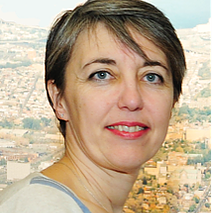Véronique Moulin, Ph.D.

Professeure-chercheure
Tél: 418 649 0252 poste 61715
This email address is being protected from spambots. You need JavaScript enabled to view it.
Dons à la recherche (Philanthropie) : Fondation du CHU de Québec - Université Laval
La cicatrisation cutanée est un processus complexe qui, lorsque pris en défaut, peut entrainer une morbidité et une mortalité importantes. Mes travaux de recherche visent à approfondir nos connaissances relatives aux mécanismes de la cicatrisation normale et pathologique de la peau. Pour ce faire, j’utilise différents modèles de culture cellulaire par génie tissulaire permettant de reproduire in vitro les pathologies fibrotiques de la peau (cicatrices hypertrophiques, sclérodermie). Je fais également appel à des modèles animaux afin de compléter mes recherches.
Thèmes de recherche
1- Les myofibroblastes dans les cicatrices normales ou pathologiques
Ces cellules apparaissent lors de la cicatrisation des plaies et ont un rôle important dans la contraction des bords de la plaie. Nous avons montré que ces cellules ont également un rôle central dans la production de la matrice extracellulaire ainsi que dans l’angiogénèse. Elles ont un rôle dans la formation de cicatrices invalidantes comme les cicatrices hypertrophiques.
a) Analyse des différentes fonctions des myofibroblastes dans la cicatrisation normale ou pathologique;
b) Étude des interactions existantes entre les différents types cellulaires de la peau (cellules endothéliales, kératinocytes, fibroblastes et myofibroblastes)- rôle de différentes cytokines dans ces interactions; évaluation du rôle des microparticules dans les interactions cellulaires;
c) Rôle de la matrice extracellulaire sécrétée par les cellules dans les différentes fonctions cellulaires comme l’apoptose, l’angiogénèse ou la différenciation cellulaire.
3- Étude de la sclérodermie systèmique
Cette pathologie est une maladie fibrosante qui rigidifie l’ensemble des organes dont la peau et qui est mortelle à long terme.
a) Utilisation du génie tissulaire pour comprendre cette pathologie dans la peau;
b) Rôle de l’apoptose dans la sélection de certaines cellules au cours du développement de la fibrose.
4- Action des champs électriques épidermiques sur la cicatrisation
5- Application clinique du génie tissulaire dans un contexte de cicatrisation pathologique
Pour atteindre cet objectif, j’utilise différentes techniques de biologie cellulaire et de génie tissulaire assorties à des analyses biochimiques, histologiques et moléculaires. La compréhension de ces mécanismes a pour but de déterminer de nouveaux traitements afin d’intervenir de façon préventive ou curative dans la formation des cicatrices hypertrophiques et dans la sclérodermie.
Techniques utilisées
- Biologie cellulaire appliquée au secteur de pointe en génie tissulaire;
- Culture de cellules humaines primaires en monocouche;
- Production et analyse de tissus reconstruits;
- Histologie et analyse de tissus/cellules par immunohistochimie;
- Analyses biochimiques (cytométrie en flux, Western blot, électrophorèse en deux dimensions, ELISA, etc.);
- Biologie moléculaire (transduction virale, qRT-PCR, etc.).
Opportunités de formation
Nous sommes présentement à la recherche d’étudiants motivés et dynamiques intéressés à joindre notre équipe pour effectuer des études graduées de 2ème ou de 3ème cycle ou pour effectuer un stage post-doctoral.
Envoyez les documents suivants par courriel à This email address is being protected from spambots. You need JavaScript enabled to view it.:
- Lettre de motivation
- Curriculum Vitae
- Relevé de notes
- FPfau
